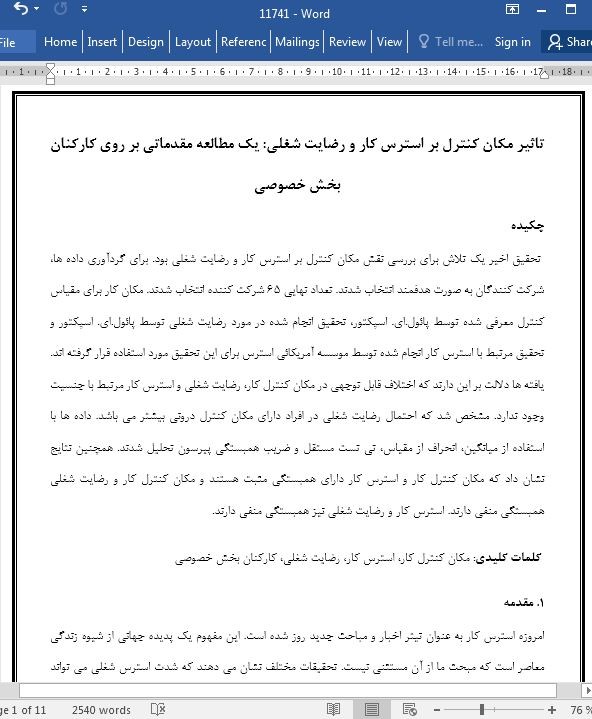
تاثیر مکان کنترل بر استرس کار و رضایت شغلی
چکیده
تحقیق اخیر یک تلاش برای بررسی نقش مکان کنترل بر استرس کار و رضایت شغلی بود. برای گردآوری داده ها، شرکت کنندگان به صورت هدفمند انتخاب شدند. تعداد نهایی 65 شرکت کننده انتخاب شدند. مکان کار برای مقیاس کنترل معرفی شده توسط پائول.ای. اسپکتور، تحقیق انجام شده در مورد رضایت شغلی توسط پائول.ای. اسپکتور و تحقیق مرتبط با استرس کار انجام شده توسط موسسه آمریکائی استرس برای این تحقیق مورد استفاده قرار گرفته اند. یافته ها دلالت بر این دارند که اختلاف قابل توجهی در مکان کنترل کار، رضایت شغلی و استرس کار مرتبط با جنسیت وجود ندارد. مشخص شد که احتمال رضایت شغلی در افراد دارای مکان کنترل درونی بیشتر می باشد. داده ها با استفاده از میانگین، انحراف از مقیاس، تی تست مستقل و ضریب همبستگی پیرسون تحلیل شدند. همچنین نتایج نشان داد که مکان کنترل کار و استرس کار دارای همبستگی مثبت هستند و مکان کنترل کار و رضایت شغلی همبستگی منفی دارند. استرس کار و رضایت شغلی نیز همبستگی منفی دارند.
1. مقدمه
امروزه استرس کار به عنوان تیتر اخبار و مباحث جدید روز شده است. این مفهوم یک پدیده جهانی از شیوه زندگی معاصر است که مبحث ما از آن مستثنی نیست. تحقیقات مختلف نشان می دهند که شدت استرس شغلی می تواند به سلامت فیزیکی و ذهنی کارکنان صدمه وارد کند و در نهایت منجر به بازده، رضایت شغلی و سلامت کمتر کارکنان شود. نمی توان استرس کار در داخل شرکت را نادیده گرفت. تحقیق انجام شده توسط آندرسون نشان می دهد که استرس به میزان کم یا زیاد در هر سازمانی اتفاق می افتد و به نوبه خود بر عملکرد نهایی کارکنان تاثیر می گذارد. برای نمونه (پیکر نیک 2001) بیان کرده است که تاثیرات استرس در کار می تواند متفاوت و با نتایج ضعیف همراه باشد و افزایش بیماری، غیبت، ترک خدمت کارکنان را شامل شود. علاوه بر این، تنش معمولا با کارشکنی های صنعتی در ارتباط است.
9. نتیجه گیری
در مجموع، می توان بیان کرد که کنترل کار دارای همبستگی مثبت با استرس محل کار می باشد و رضایت شغلی همبستگی منفی با استرس محل کار و مکان کنترل دارد. اختلاف قابل توجهی در استرس محل کار، رضایت شغلی و کنترل کار و کنترل جنسیت وجود ندارد. نتایج بیان می کند که کارکنانی که کنترل درونی دارند رضایت بیشتری را در مقایسه با کارکنان دارای کنترل بیرونی گزارش کرده اند. این تحقیق بر روی کارکنان سازمان های بخش خصوصی انجام شده است. پیشنهاد شده است که این تحقیق می تواند بر روی جمعیت بزرگی انجام شود تا تعمیم بخشی بیشتری از نتایج و یافته ها ارائه شود.
Abstract
The current study was an attempt to investigate the role of locus of control on work stress and job satisfaction. To collect data, participants were selected purposively. A total of 65 respondents were selected. The work locus of control scale by Paul E. Spector, job satisfaction survey by Paul E. Spector, and workplace stress survey by The American Institute of Stress were used for the study. The findings indicate that there was no significant difference in work locus of control, job satisfaction, and workplace stress concerning gender. It was found that individuals with an internal locus of control are more likely to have higher job satisfaction. The data were analyzed using mean, S.D, Independent t-test, and Pearson's correlation coefficient. Results also showed that work locus of control and workplace stress was found positively correlated; work locus of control and job satisfaction were found negatively correlated; workplace stress and job satisfaction were negatively correlated.
1. Introduction
Stress at work has been the headline of news stories and the talk of the day these days. It is a global phenomenon of contemporary lifestyles that our island is no exception to. Various studies show that intense job stress can harm workers' mental and physical health, which eventually leads to lower productivity, less job satisfaction, and less healthy employees. It is not possible to ignore the work stress within the company. A study conducted by Anderson shows that stress occurs in any organization high or low, and which in turn affects the overall job performance of the employees. For example, (Pickering,2001) notes that the effects of stress in the workplace can be very varied and along with poor results, including elevated illness, absence, and staff turnover. Moreover, tension has frequently been related to industrial sabotage.
9. Conclusion
In conclusion, it can be stated that work locus of control is positively correlated with workplace stress; and job satisfaction is negatively correlated with workplace stress and work locus of control. There was no significant difference in workplace stress, job satisfaction, and work locus of control with gender. The results indicate that employees with an internal locus of control reported higher job satisfaction when compared to employees with an external locus of control. The present study was conducted on employees in private sector organizations. It can be further suggested that this study can be conducted on a larger population to establish greater generalizability of these findings.
چکیده
1. مقدمه
2. سوالات تحقیق
3. اهداف
4. فرضیه ها
5. روش شناسی
6. ابزار مورد استفاده
7. متغیر های تحقیق
8. نتایج& بحث
9. نتیجه گیری
منابع
Abstract
1. Introduction
2. Research questions
3. Objectives
4. Hypotheses
5. Methodology
6. Tools used
7. Research variables
8. Result & discussion
9. Conclusion
References
- اصل مقاله انگلیسی با فرمت ورد (word) با قابلیت ویرایش
- ترجمه فارسی مقاله با فرمت ورد (word) با قابلیت ویرایش، بدون آرم سایت ای ترجمه
- ترجمه فارسی مقاله با فرمت pdf، بدون آرم سایت ای ترجمه



